
Let's face it, "power walking" doesn't sound all that fun. But, fortunately, you don't need to wear ankle weights and pump your arms to benefit from a walking program. After all, the best exercise is the one you love doing. And what's more enjoyable than going for a stroll?
Walking supports heart health, promotes energy and helps decrease stress, so it's no surprise it's the country's most popular form of exercise. More than 30 percent of Americans walks on an average day, according to the U.S. Bureau of Labor Statistics.
Video of the Day
Video of the Day
To get moving, try this four-week beginner walking program, from New York-based physical therapist and trainer Sam Becourtney, DPT, CSCS. By the end of the plan, you'll tackle a 30-minute walking workout in stride.
Read on and get ready to put one foot in front of the other.
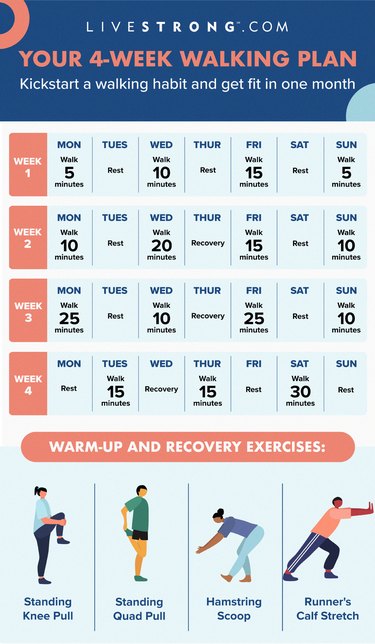
Week 1
During this first week, don't worry about speed-walking down the block. Instead, keep a gentle pace and even, controlled breaths, Becourtney says.
On rest days, kick up your heels. If you feel up to it, you can do 15 to 20 minutes of dynamic leg stretches (like the ones listed below!) to loosen things up and get your blood flowing.
- Monday: Walk 5 minutes
- Tuesday: Rest
- Wednesday: Walk 10 minutes
- Thursday: Rest
- Friday: Walk 15 minutes
- Saturday: Rest
- Sunday: Walk 5 minutes
Week 1 Total: 35 minutes
Tip
Feel free to move around the listed rest days. Remember, this is your first week with a new activity. Prioritize your body's needs over the above schedule, Becourtney says.
Week 2
This week, you start to build your speed and endurance. During 10- and 15-minute walking workouts, try to increase your pace from last week. On Wednesday, you have a 20-minute walk planned. Your pace can and should be slightly slower.
- Monday: Walk 10 minutes
- Tuesday: Rest
- Wednesday: Walk 20 minutes
- Thursday: Recovery
- Friday: Walk 15 minutes
- Saturday: Rest
- Sunday: Walk 10 minutes
Week 2 Total: 55 minutes
Tip
"Start to play around with the length of your strides to determine the preferred distance of your steps to improve your walking pattern," Becourtney says.
Week 3
During this third week, your total distance and time will increase beyond an hour (what a great achievement). During your longer walks, take pauses to rest as needed, Becourtney says.
- Monday: Walk 25 minutes
- Tuesday: Rest
- Wednesday: Walk 10 minutes
- Thursday: Recovery
- Friday: Walk 25 minutes
- Saturday: Rest
- Sunday: Walk 10 minutes
Week 3 Total: 70 minutes
Tip
As your walks get longer — especially in warm weather — make sure to bring a reusable water bottle with you.
Week 4
On these days, start slower than you want to. When you're about halfway through each walk, try to pick up the pace, Becourtney advises.
This week will get you to a 30-minute walk in one session — an excellent accomplishment.
- Monday: Rest
- Tuesday: Walk 15 minutes
- Wednesday: Recovery
- Thursday: Walk 15 minutes
- Friday: Rest
- Saturday: Walk 30 minutes
- Sunday: Rest
Week 4 Total: 60 minutes
Tip
This week is shorter in total time than last week, but includes a longer walk in one session. Keep a comfortable pace and consider bringing some headphones and workout music on the road with you.
Do These 4 Warm-Up and Recovery Exercises
Before your workout, always prep your body with a dynamic walking warm-up.
"I generally recommend some dynamic mobility stretches before walking and potentially more prolonged stretches after more vigorous walking," he says. "I recommend standing stretches since these most directly correlate to the activity of walking."
Gentle exercises are also great for rest and recovery days to ease any delayed-onset muscle soreness.
He recommends these four dynamic stretches. Do 2 sets of 12 reps per leg.
Move 1: Standing Knee Pull
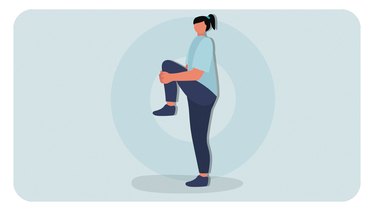
- Stand tall with your feet together.
- Keeping a flat back, hug one knee to your chest
- Holding the stretch for a few seconds.
- Lower your foot to the floor, then switch sides.
Tip
If you're having trouble staying balanced, place one hand on a wall or sturdy piece of furniture for support.
Move 2: Standing Quad Pull
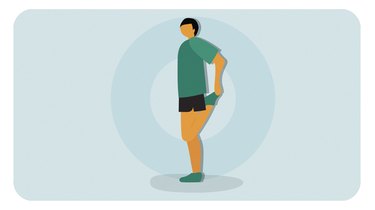
- Stand tall with your feet together.
- Bend one knee and gently grab your ankle with that side's hand.
- Slowly pull your heel toward your glutes.
- Squeeze your glutes and make sure your knees are in line with each other.
- Hold for a few seconds, then switch sides.
Move 3: Standing Hamstring Scoop
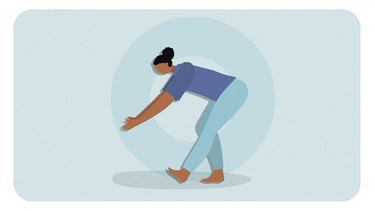
- Stand tall with your feet together.
- Step one foot in front of you with your heel down and toes pointed toward the ceiling.
- Keeping your knee straight, slowly hinge your hips behind you and let your torso fall forward. At the same time, scoop your arms down toward the floor in front of you.
- Raise back up to stand.
- Do all reps, then switch sides.
Move 4: Runner's Calf Stretch
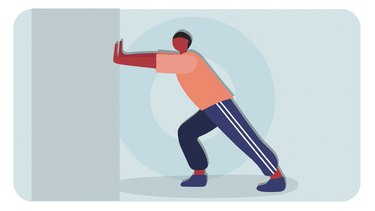
- Stand tall with your feet together, and step one leg in front of you.
- Keeping your back leg straight and heel against the floor, slowly bend your front knee and shift your weight forward. You should feel a stretch in your back leg's calf.
- Hold for a few seconds, then straighten your front knee to release the stretch.
- Do all reps, then switch sides.
3 Tips to Get the Most from Your Beginner Walking Program
1. Wear Walking Shoes
Before you kickstart your walking program, equip yourself with a pair of proper walking shoes that are best for your feet and needs. For example, you'll need different shoes if you're walking on pavement or on a rocky trail. And your shoes should always fit any pronation or stability concerns you have.
2. Stand Tall
Bring your shoulders down and back and keeping your eyes up at all times, no matter how tempting it may be to look at the ground. According to Harvard Health Publishing, hunching your shoulders while you walk can limit airflow into and out of your lungs.
3. Warm Up and Cool Down
Particularly in the beginning stages of your walking plan, you'll want start each walk with a few of the dynamic stretches listed above. This will help increase blood flow through your body and prep your muscles.
And even if you don't break a sweat during your walks, it's best to finish up with a cool-down routine, Becourtney says. Cool-down stretches don't have to take too long — even just 3 minutes will do. Try holding a few static lunges or doing the cat-cow yoga pose.
As you grow more comfortable with walking, it'll probably be even more tempting to skip these parts of your workout. Stick with them to stay on an injury-free path.
Was this article helpful?
150 Characters Max
0/150
Thank you for sharing!
Thank you for your feedback!